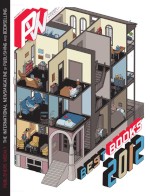Ellen Forney, 44, didn’t want to include herself in her new graphic memoir about bipolar disorder. But the facts were these: in 2000, Forney was diagnosed with bipolar disorder, a mental illness that exaggerates one’s high and low moods—occasionally driving the sufferer to suicide—and she wanted to learn more about it and others to understand it, too.
Her brave graphic memoir Marbles: Mania, Depression, Michelangelo, and Me (Gotham Books) looks at bipolar disorder through the prism of her own troubled past: her manic sprees, debilitating depression, and strained relationships. “The first incarnation in my head was that I was going to do a book of bipolar case studies,” she says from her home in Seattle. Forney was reticentand “scared” to record her personal experience. But luckily, she says, a friend of hers pointed out that her own story was really the most interesting part.
At the time Forney was diagnosed, she was a rising star in the comics world, drawing strips for the alt weekly the Stranger, launching her memoir I Was Seven in ’75 with Fantagraphics, and taking on a project for its erotic imprint Eros Comix. She was in the midst of a creative blitz—and then had a meltdown. Forney spoke with a psychiatrist who prescribed lithium; at that point, Forney began a series of sometimes helpful and sometimes harmful meds to alleviate her illness. Of her condition, Forney says, “I remember it dawning on me, oh, I’m going to have to deal with this in a comic!”
She embarked on the four-year journey to create Marbles, which comprised extensive research, interviews and personal journal excerpts. She enlisted a research assistant, Jamie Vann, who gathered data on bipolar disorder and case studies. Forney consulted, among other texts, Touched with Fire by psychiatry professor Kay Redfield Jamison on the connection between mood disorders and creativity. Forney also interviewed her mother and various friends for their perspectives on her struggle for emotional stability. And the author included her actual drawings from her sketchbook, each one a deftly fragile snapshot of madness.
With three mandates in mind—to tell her story, include case studies of artists with mood disorders, and explore the link between mental illness and creativity—she began to fold the three narratives into a singular book. But with such personal issues at the fore, completing the manuscript was a challenge. “I did a lot of sitting in the local tea cafe and typing on my laptop and going to the bathroom to blow my nose when I was crying,” says Forney. Indeed, she lays bare her shattered state in the book. She writes that, as with Sylvia Plath, “A sense of electrical current was part of my own experience of being manic. The sensation that my mind was spinning and overheating would sometimes build to a sensation like an electrical short—a burst of light, a melting, or dissipating—and I’d get a metallic taste in my mouth, like when you lick a battery.”
But through her painful firsthand experience with bipolar disorder and her re-creation of it through drafting her graphic memoir, Forney had a revelation: “When you read an interview with a fiction writer, they talk about their characters taking on their own lives and making their own decisions, and being surprised by the things that their characters do and come up with. I never understood that. And I’d say that, in the course of doing Marbles, there were a lot of things that were like that. There were things that the story just called for: it called for a reflection here, it called for a drawing there, it called for a wordier page here that looked forward or reflected back. So in a way, I felt like I was pulling the story almost from something that already was there.”
Indeed, her voice in Marbles is bold, and the combination of her story with those of other afflicted artists is seamless. Forney’s condition stabilized in 2004, and her progress toward a balanced life hasn’t marred her humor or creativity. She has translated her torment into a vulnerable, honest, and darkly funny self-portrait in Marbles. And in her quest to create this book, she has transformed the way she looks at the darkest part of her life: “I figure it’s like pulling out a big splinter. It’s under the surface, and it hurts, but you kind of keep it pushed down. Pulling it out is really, really difficult,” she says, “but once it’s out, you can look at it and say, wow, that’s what it was. And then it can heal.”



 Volume 259
Issue 45
11/05/2012
Volume 259
Issue 45
11/05/2012





